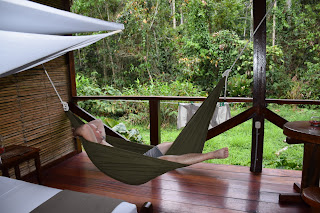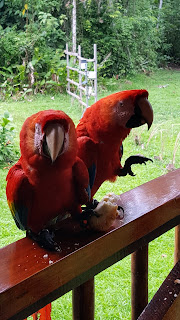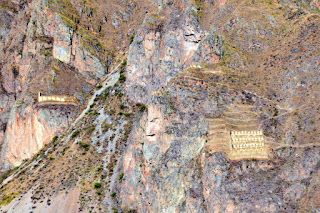We planned a 14 day trip that included 3 days in Lima, 1 day in Puerto Maldonado 5 days in the Peruvian Amazon and 5 days in and around the Sacred Valley to include Cusco and Machu Picchu. Our original plan was to fly out on Oct 7th with a connection through Miami but unfortunately Hurricane Matthew made land fall that morning so we didn’t end up flying out until the 9th on a red eye :( still it was a direct flight so we only missed the Lima part of our trip. That said we flew to Puerto Maldonado on the afternoon of the 10th and the next day we headed into the jungle of the Tambopata National Reserve located in the Amazon Basin of southeast Peru, and spans vast areas of biodiverse savannahs and rain forest.
Our guide (Pedro) picked us up at our hotel and we took an hour bus ride to the Tambopata River where we got on a boat and headed south to our first stop, a lodge 3.5 hours upstream (rivers run south to north in the southern hemisphere) to spend the night before heading to our final destination the Tambopata Research Center (TRC) which is an addition 4 hours upstream. We booked this leg of our trip with Rainforest Expeditions which is a Ecotourism company that has operated in the Tambopata National Reserve since 1989. They began as a research effort and created the Tambopata Research Center to work on macaw conservation research. This research is still conducted at TRC and is headed by a professor from Texas A&M University. Upon boarding the boat the first order of business was lunch, consisted of vegetables and rice wrapped in a leaf. Yum!
Once we started began our journey the wildlife sightings began almost immediately.
We arrived at our first stop (Refugio Amazonas) just before the sun went down and were greeted by the manager of the lodge with a cold washcloth and refreshing lemonade. As you can imagine it is hot and sticky in the rainforest so these were welcome surprises. Refugio Amazonas is the biggest of the lodges operated by Rainforest Expeditions and was built by and employs the local community. Actually the local community gets 70% of the profit that is generated by the Ecotourism Company thereby creating an environmentally sustainable economic value for the land and incentives the local community to protect the forest and its natural resources. The lodge was built with the materials that the forest provided (check out the beautiful wood). We had some time before dinner so we went to our room, which is open to the forest, and listened to the sounds of the jungle and admired the everything about the natural world around us.
The next morning we headed into the jungle early to get a quick hike in before we headed to TRC. We headed off to what Pedro call the “canopy tower” which turned out to be a 120ft high this! EEK!! While this freaked me out (I hate heights) the view from the top was worth it.
After some time admiring the top of the tree line we headed back to the lodge for breakfast. On our way back Pedro pointed out the flora and explained the different fauna we could hear. We even came across some Pale-winged trumpeters as they make their way through the forest.
Then it was back to the boat for our final stretch on the river and 4 more hours upstream.
Peru’s top 3 economic industries are mining, agriculture, and tourism. Since Peru is still a developing country and its people are mostly poor many Peruvians are attracted to the high pay/high risk of illegal mining for gold dust. To give you a sense of scale, a teacher can make up to $1600 Sol a month ($470 USD) a miner can make that in a day, assuming they get paid.
In order to extract the gold dust from the ground the land is deforested and the earth is polluted with mercury in order to bind the dust and separate it from the earth. There are no protective measures for the miners so their exposure to mercury leads to cancer and what it does to the environment is just heartbreaking. Sadly we did see a few illegal mining operations between the first and second check points going into the Tambopata National Reserve.
Once we arrived at TRC we were given a quick rundown of the research being down with the macaws and we were told that in the 1990s the research effort included incubating macaw eggs that had low survival probabilities in the wild and raised the chicks in semi-captivity. Macaws can have up to 4 eggs but will only feed the first and sometimes the second hatchling and leave the rest to die in the next. So the researchers were taking the disregarded chick and raising them to maturity at TRC. They stopped this practice when it became apparent that these birds were no longer afraid of people and kept flying back to the lodge to steal food! They warned us that it is common to see some 20+ year old macaws show up for a snack but don't feed them on purpose.
The battle rhythm of jungle goes like this, between 0430 to 0500 the Howler Monkeys wake up and in the same way that the rooster announces the sun to the farm the Howler Monkeys announce the sun to the jungle. It is something. At 0400 we get up to head to the clay lick (by boat) to check out the macaws and parrots being their day.
Then we head back to the lodge for breakfast. After breakfast we go back into the forest to see what we can see.
Then back to the lodge for lunch and siesta.
And out again for a twilight hike.
After 5 days in the jungle we headed back to Puerto Maldonado (down stream this time so we can make the trip in 3 hours vs. 8) and fly to Cusco for our Sacred Valley adventure.
We headed to Cusco on October 16th which is a 30min flight from Puerto Maldonado. Something that we noticed about Peruvian culture is that schedules are a suggestion. We took a total of 5 flights within the country and they were all late. Also security is not really a thing. For example this little terrorist wanted to take her juice box to the gate but when the security guard tried to take it she cried so she got to keep it. But don’t worry.. they wouldn’t let me take the water I bought at the gate on my flight back to the states so at least they have our backs.
Descending into the airport we noticed that we barely dipped below the clouds before hitting the runway. We took this pic approx. 1 min before landing. Cusco City is 3.4 kilometers above sea level (11,200 ft). We took altitude medication to avoid getting sick and we were mostly fine, but we learned that altitude affects your breathing, muscle stamina, sleep and even appetite. Regardless, our first night we caught our breath long enough to notice that Cusco is an amazing place. The central part of the city’s cultural life is the Plaza de Armas, which is a living monument to the clash of Incan and Spanish cultures (now also featuring a Starbucks and McDonalds). Narrow cobble stone streets occasionally turn into stairs between buildings still resting on 500 year old stone foundations. The current irrigation systems is built on top of the still functioning system that also dates back to the days when Cusco was the capital of the Incan empire. Add many gothic cathedrals, colorful fabics, lights and the hustle of a functioning city and you get the idea of the charm of this place.
Not to mention the women walking around with baby lambs and lamas!
First things first- a primer on the Incans. The Quechua were the inhabitants of the region; the Incan’s were ethnically distinct and were a ruling class among them. Many of the structures we visited were pre-Incan, but later improved upon by the Incan building techniques. They built their cities out of stones that they fit together like Legos and were even able to carve corners out of one stone.
Our tour guide during the Incan portion of our trip was Jaime (pronounced like “hi-me”). His first act as our guide was to introduce us to the Spanish influence on the region by giving us a tour of the main cathedrals in the Plaza de Armas. As Jaime said, the Spaniards didn’t just take over the region using guns, germs, and steel; they used Catholicism as well. The Spanish wanted to make sure that the Inca people would assimilate to the Christian faith so they presented more women saints then men (think Mother Earth) and dressed the women to have the shapes mountains. They also depicted Jesus as bloody as a Mel Gibson film and always looking down at Mother Earth to pray. Several of the religious figures in the locally drawn paintings also had puffy cheeks from chewing Coca leaves and there was also a painting of the last supper which included a feast of guinea pig. Because, you know, guinea pig is considered a fancy dinner in Peru. Also, in 1935 some dude decided that the Inca had a flag... turns out it was the Pride flag. So the Pride flag flies throughout the sacred valley.
Our first Incan site was Saksaywaman, which is a military fortress above Cusco. Of the Inca sights we visited 80% of them were built by the Ninth Inca, Pachacuti (1438–1471) Our second site was Tambomachay; which was a wa’ka (sacred site) further north of the city and higher in the Andes (close to the tree line). The site was a built atop an existing natural spring and, while it did have spiritual significance, may have served the practical purpose of being a way-point for those traveling the Incan trail away from Cusco. Q’inqu is a wa’ka also just north of the city. This was our last stop on our first day of the Incan tour.
Our first stop on our second day was an animal refuge on the way to the fortress Puka Pukara. We had mixed feelings about the animal refuge; the stated mission of the site was to rescue animals from bad environments and re-introduce them into the wild. This is where we saw the infamous Turducken!
Then we were off to Sacred Valley for stops at Puka Pukara, Pisac, and Ollantaytampbo.
Ollantaytambo was built across from a Mt that had a face on it. You can see the other structures that they built next to the face... these cats really knew what they were doing.
Remember how I said that Peruvians eat guinea pig? Well they also raise them in their homes which not more then a square room like this. Notice that dinner takes up half of the space!
We spent the night at a nearby inn where we drank wine outside and spotted the Southern Cross in the night sky. Very cool. Then it was up early for our second day in the Sacred valley with stops at Chinchero and Moray (an Incan amphitheater and agricultural experimentation) and a Salt Farm.
Then it was off to Aguas Calientes for our last stop before Machu Picchu.
Oh and there were stray dogs EVERYWHERE throughout Peru but none as cool as this guy we saw in Aguas Calientes... this dude owned that town!
The next day were were in line at 0500 to get a bus to Machu Picchu.
As you can see this is a very long line but lucky us we made it there in time to catch the first round of buses which meant that we were inside of Machu Picchu by 0630.
 The Incas built the estate around 1450 but abandoned it a century later at the time of the Spanish Conquest. Although known locally, it was not known to the Spanish during the colonial period and remained unknown to the outside world until American historian Hiram Bingham brought it to international attention in 1911.
The Incas built the estate around 1450 but abandoned it a century later at the time of the Spanish Conquest. Although known locally, it was not known to the Spanish during the colonial period and remained unknown to the outside world until American historian Hiram Bingham brought it to international attention in 1911.
We hiked around Machu Picchu for approx four hours and headed back down to Aguas Calientes for lunch just before it started to rain. You can see it coming in the distance.
And that was that! We had lunch and took a train back to Cucso so we could fly home the next morning at 0530. Some final thoughts on Peru: it was a beautiful country but also a developing one. While they do have some environmental laws they are not enforced so the cities smell of car emissions and the rain forest is being destroyed. There are not always paved roads to drive on and many of the homes are barely more then modest huts. While they do have western toilets you can not flush the paper and the stray dogs rip apart garbage bags in the street. So while it was a fantastic vacation it was also a reminder of just how good we have it here in the USA.
We hope you enjoyed our blog and pictures:) Until next trip, Cheers!






































































